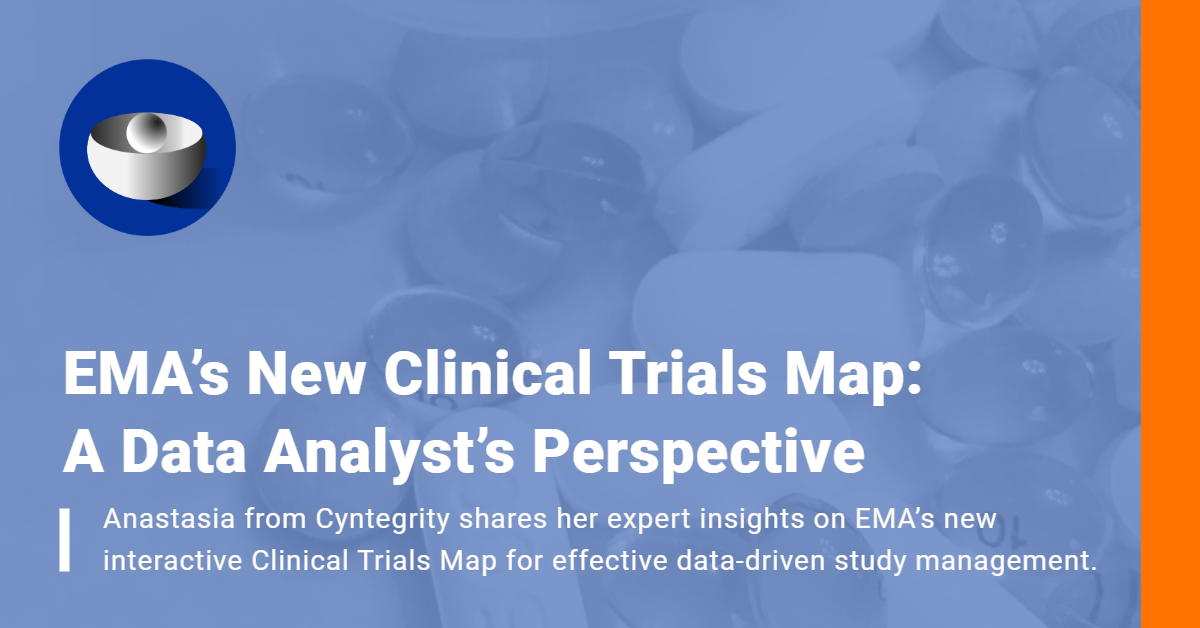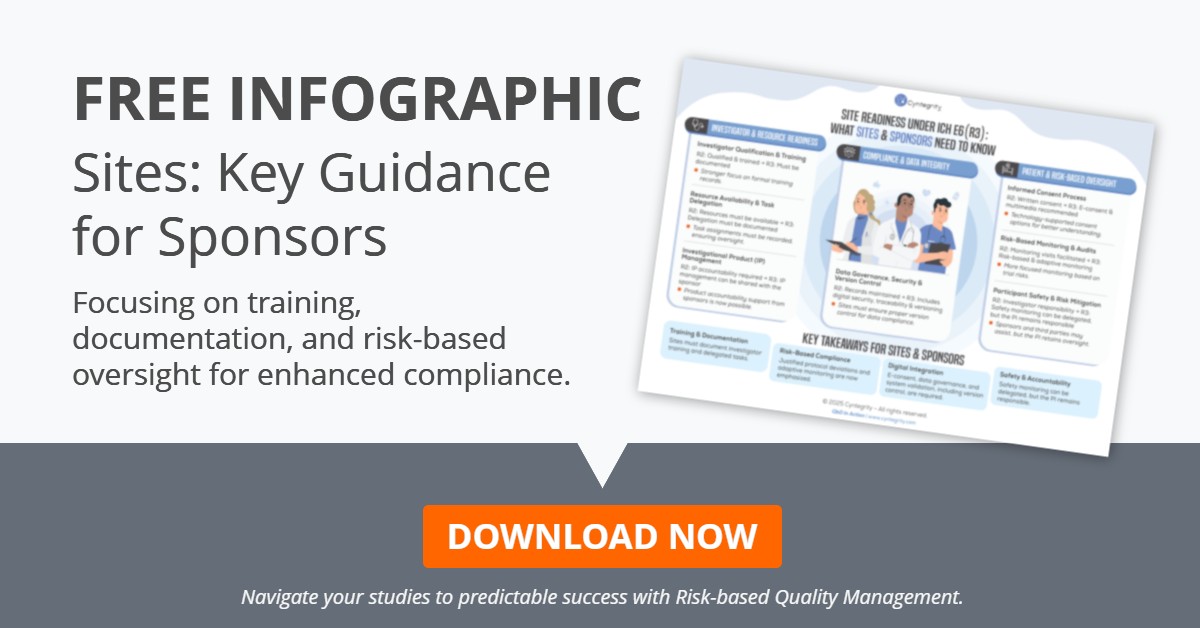FDA RBM Q&A Draft Guidance for Industry
The FDA risk-based guidance and the European Medicines Agency (EMA) quality management reflection paper opened the door for the risk-based monitoring (RBM) of clinical investigations in 2013. After some initial hesitation, the clinical research community now seems to embrace the modern concept of RBM. In response to the industry’s many burning questions, the FDA recently drafted a structured Q&A that builds on the agency’s risk-based monitoring guidance. In this blog we analyze Cyntegrity’s RBM process-technology fit based on this latest guidance document.
 As with all new developments, the actual interpretation and implementation raise questions across the pharma industry, which is also observed by the Clinical Data Management (CDM) and RBM DIA Communities (A Roadmap for Implementing RBM and QM). To address the need for clarification, the US Food and Drug Administration published a draft Q&A on risk-based monitoring in last March. This additional guidance is intended to assist Sponsors and CROs in planning, conducting and reporting risk-based approaches to monitoring.
As with all new developments, the actual interpretation and implementation raise questions across the pharma industry, which is also observed by the Clinical Data Management (CDM) and RBM DIA Communities (A Roadmap for Implementing RBM and QM). To address the need for clarification, the US Food and Drug Administration published a draft Q&A on risk-based monitoring in last March. This additional guidance is intended to assist Sponsors and CROs in planning, conducting and reporting risk-based approaches to monitoring.
Our team of clinical experts reviewed the recent RBM Q&A draft guidance document as well and extended the FDA publication with RBM solution specific insights and a downloadable mind map to help you even further.
The RBM Process-Technology Fit
Keep the FDA RBM Q&A guidance document at hand. Click here…
Q1: What is the purpose of the risk assessment and should sponsors document their methodologies and activities for assessing risk?
To question 1 – Cyntegrity’s cloud-based @RACT tool meets exactly those requirements mentioned in the FDA’s answer;
- @RACT supports the identification of critical data and processes
- Documents the decisions made with regards to what is important and critical
- Learns while working with the system, and so facilitating an overall improvement of the drug development process
- Facilitates workflow management in the background ensuring conclusions from the risk assessment are being documented, mitigation actions are being planned and used, accountable people and roles are being identified, and every step in the process is being recorded in an audit trail
Risk assessment and categorization as well as the conclusion drawn can be extracted and become part of the monitoring plan, whether a centralized monitoring plan or the site monitoring plan.
Q2: Should sponsors monitor only risks that are important and likely to occur?
To question 2 – Cyntegrity’s cloud-based @RACT tool also addresses those requirements;
- Our self-learning @RACT tool facilitates the definition of risks, the collation of Key Risk Indicators (KRIs), the assessment of impact, probability or likelihood and detectability
- All criteria (impact, likelihood, detectability) come along with a definition for ease of use
- @RACT can be modified during a study once the sponsor or CRO learned about additional risks, as well as facilitates the modification of risk indicators, thresholds, mitigation actions, accountabilities, etc.
- Also risks identified by other means than analyzing the data can be managed via our @RACT tool
- All actions are being recorded in the audit trail
Q3: What factors should sponsors consider when determining the timing, types, frequency, and extent of monitoring activities?
To question 3 – Cyntegrity’s cloud-based @RACT tool in combination with Cyntegrity’s intelligent EarlyBird® system can handle all of the requirements mentioned in the FDA’s answer;
- Our @RACT tool can handle complex study designs like stratification, balanced designs, cross-over designs, etc.
- Any type of endpoint can be identified as a risk, whether an outcome, a lab value, signs, and symptoms, patient-reported outcome or data from wearable devices
- Our system can handle different scenarios of differently ill patients and advise on appropriate on-site monitoring frequency and depth of the monitoring
- EarlyBird can drill down into any level of analysis, such as analyses by study, by region, by country, by site, by patient, by CRF form or even by data field on the CRF
- Detailed site analyses can be displayed on customizable dashboards
- Analyses can be triggered more frequently at the beginning of a study and driven down once more information about the progress or the site performance is available
- EarlyBird can also handle manually identified issues, such as staff turnover, problems with the study drug storage, or any other issues that cannot be derived from data in the EDC system or any other system
- Patient burden can be detected during the study by taking a closer look at the data and in particular at an increasing number of missed visits for example
- Our system is flexible enough to trigger early monitoring visits and later – if performance of the sites permits – use a more relaxed approach to monitoring, in particular to source data verification
- EarlyBird can be configured such that a monitoring plan can be adjusted based on the findings, the various sites, the safety profile of the drug under development or any other criterion
Q4: How can a risk-based approach to monitoring that includes centralized monitoring help minimize missing data, protocol violations, or protocol deviations?
To question 4 – Cyntegrity’s intelligent EarlyBird® system can handle all of the requirements mentioned in the FDA’s answer;
- EarlyBird provides predictions of any data of interest, broken down by study, country, or site, which means for example:
- Prediction of the enrollment based on the first subjects enrolled
- Predictions of the date the study will likely be able to be completed
- Predictions of query response times
- Predictions of which sites will become the rate-limiting factor with regards to the database lock
- Predictions of the number of valid patients taking into account protocol violations
- The results of mitigating actions and CAPA actions can be seen in our system – if they worked – as serve as the basis for future studies
Q5: Should the risk-based monitoring approach include processes to ensure that appropriate blinding is maintained?
To question 5 – Cyntegrity’s intelligent EarlyBird® system can handle all of the requirements mentioned in the FDA’s answer;
- Our system supports maintenance of the blinding since it can be configured such that the user will not see data potentially unblinding the user
- On the other hand, the system may be able to detect abnormal data pattern indicative of a potential unblinding of site staff and trigger appropriate actions to prevent such an unblinding from happening elsewhere or again
Q6: What elements should sponsors include in monitoring plans?
To question 6 – Cyntegrity’s systems facilitate a smoother on-site monitoring since it helps in the preparation of the monitoring visits, by;
- The built-in identification of critical data and critical processes prior to the start of a study
- Facilitating the documentation of trial specific risks, e.g. the subject enrollment and even the prediction of the subject enrollment
- Accommodating the clear definition of who is responsible within the organization for looking at what type of data and which systems
- The extent of built-in monitoring activities (Earlybird) and alerts being forwarded to the accountable individual
- Tracking of protocol deviations and raising flags in case thresholds are being exceeded
- Audit-trailing of all activities within our Earlybird system, ensuring a seamless tracking of all activities related to the risk-based monitoring
Cyntegrity’s systems is being built such that;
- System as well as manually detected issues in a study are being managed through our system, and escalated if applicable until complete resolution of the issue
- The communication channel is bi-directional – all within the system without external applications required
- Open issues are being escalated
- Serious or repetitive issues can easily be moved to a CAPA system and be addressed in the CAPA system
- Audits can easily be planned by auditors by reviewing the EarlyBird system and review of areas of interest. By the way, the same is true for CRO oversight, since the system is frequently being used for CRO oversight activities
- Our system is extremely flexible – though everything is being tracked and audited – such that the monitoring plans can be adjusted in case a sound reason can be provided and documented
Our system;
- Can supervise a proper randomization and stratification (if applicable) ensuring a balanced treatment allocation as per protocol
- Provides guidance on which countries or sites or patients or CRF pages should preferably be monitored (i.e. SDV’d) since the signals provided by EarlyBird warrant a closer review of those data
- Provides a quick though clear overview of critical areas that require attention by provision of an intuitive dashboard
- Permits a drill down from a study (or project) level, to the country or site level and down to the patient level, thus quickly flagging those areas that are of concern not only at one site but potentially across a country or even an entire trial
Q7: How should sponsors follow up on significant issues identified through monitoring, including communication of such issues?
To question 7 – Cyntegrity’s system;
- Facilitates tracking of any kind of issues, whether detected through the system’s algorithms or manually detected during a site monitoring visit
- The workflow management working in the background of the system ensures that no loose ends will remain either during or towards the end of the study
- Offers an inherent escalation path permitting the users to identify any party that should be alerted in case a significant issue surfaces and cannot be corrected instantaneously
Q8: Should the risk-based monitoring approach include processes to ensure that appropriate blinding is maintained?
To question 8 – Cyntegrity’s intelligent EarlyBird® system can handle all of the requirements mentioned in the FDA’s answer;
- EarlyBird has a workflow management system working in the background documenting every activity of any user
- The data reviewed – based on the highlighted areas of concern – are being documented in the audit trail for future use
- Our system permits looking at actual data as well as going back in time to review the status of the study at any point in time, from the very beginning to the very end of the study
- In addition, the automated Issue Management System (ISM) also ensures that assigned tasks to the various functional representatives are being followed up / escalated through scheduled alerts and reminders until complete resolution
- EarlyBird facilitates a timely reporting of all centralized monitoring activities
As an additional service we’ve created a Q&A Mind Map for you: “A Risk-Based Approach to Monitoring of Clinical Investigations”. Download the high resolution version here…

You can comment on any FDA guidance
The FDA encourages the public to comment on FDA draft guidances and other FDA related documents. The agency routinely allows plenty of time for public input (typically 60 days) and carefully considers these comments when it draws up a final rule. More here…






